6 Minutes
After 15 years of gamma-ray observations, astronomers have identified a faint, high-energy glow in the Milky Way's halo that could be the most persuasive hint yet of dark matter annihilation. The signal peaks at an energy consistent with popular particle models, but researchers caution that more work is needed to rule out other astrophysical sources.
A surprising glow where the sky should be quiet
The Fermi Gamma-Ray Space Telescope has been surveying the sky for nearly two decades. When University of Tokyo astronomer Tomonori Totani and colleagues stacked 15 years of Fermi Large Area Telescope data, they found a diffuse, spherical gamma-ray emission extending across the galactic halo and rising sharply at about 20 gigaelectronvolts (20 GeV).
What makes this detection notable is its combination of energy and morphology. The emission is faint but broadly halo-shaped, not concentrated along the galactic plane or confined to known point sources. That spatial pattern — roughly spherical and centered on the Galaxy — is what many dark matter models predict for annihilation or decay products.
How the team separated signal from noise
Detecting a faint halo signal is a statistical challenge. The halo is far dimmer than the busy galactic center, and gamma-ray photons at these energies are scarce. Totani's analysis relied on a long baseline of observations: compiling and cleaning 15 years of Fermi-LAT data to build a high signal-to-noise map of the diffuse emission.
To isolate the unexpected glow, the team subtracted well-known contributors to halo gamma rays: the Fermi bubbles, cataloged point sources, and diffuse emission from cosmic-ray interactions. After removing these components, a residual, halo-like excess remained and showed a spectral peak near 20 GeV — the energy range compatible with annihilation of certain weakly interacting massive particles (WIMPs).

A map that excludes all gamma radiation except the excess. The gray bar in the center blots out the galactic plane.
Why WIMPs and gamma rays are front-runners
Dark matter reveals itself gravitationally: galaxies rotate faster than their visible mass can explain, and galaxy clusters behave as if extra unseen mass is present. Particle physicists propose candidates, and WIMPs remain among the most widely discussed. In many WIMP models, particle-antiparticle collisions annihilate to produce standard-model particles, including high-energy gamma rays that telescopes like Fermi can detect.
If a gamma-ray excess appears with the right energy and spatial profile, it can be interpreted as a potential sign of WIMP annihilation. The new halo signal peaks where several WIMP scenarios predict emission, making the detection scientifically tantalizing. However, matching one predicted feature is not definitive proof: alternative astrophysical processes can sometimes mimic the same spectral shape.
Why the halo matters as much as the center
A lot of dark matter searches focus on the galactic center because theoretical models place high dark-matter density there, which should boost any annihilation signal. But the center is also crowded: millisecond pulsars, supernova remnants, and complex gas structures can produce gamma rays that confuse interpretation.
The halo, conversely, is quieter. Its lower density means any dark matter signal is fainter, but it is also less contaminated by compact gamma-ray sources. That cleaner environment makes a halo detection potentially more convincing — provided the analysis properly accounts for all known diffuse backgrounds.
Next steps: verification, cross-checks and independent searches
Science advances through replication. Totani's team published their results in the Journal of Cosmology and Astroparticle Physics, but the claim requires independent confirmation. Other groups will reprocess the Fermi-LAT dataset, apply different background models, and test whether the excess persists under alternative assumptions.
Beyond reanalysis, astronomers will search for comparable signatures in other targets. Dwarf spheroidal galaxies orbiting the Milky Way are prime laboratories: they are dark-matter-dominated and have few gamma-ray-producing astrophysical processes. Detecting a similar 20 GeV excess in dwarfs would strengthen a dark matter interpretation. Likewise, multiwavelength follow-up and stacking analyses across many galaxies could reveal consistent patterns or expose ordinary astrophysical explanations.
What a confirmed detection would mean for physics
Should the halo glow turn out to be from dark matter annihilation, it would herald the discovery of a new particle beyond the Standard Model. That would reshape particle physics and cosmology, offering direct observational constraints on mass, annihilation cross-section, and interaction channels. It would also guide terrestrial experiments and collider searches that aim to produce or study dark-matter candidates.
Still, researchers urge caution. A faint gamma-ray excess matching WIMP expectations is not yet a 'smoking gun.' Astrophysical phenomena — perhaps unknown populations of faint sources or unforeseen diffuse processes — could still account for the signal. Disentangling these possibilities will take years of careful analysis and multiple, independent lines of evidence.
Expert Insight
Dr. Elena Ramirez, an observational astrophysicist not involved with the study, says: 'This is the kind of result that wakes the community up. The energy and shape are intriguing, and the halo is an underexploited laboratory for dark matter searches. But extraordinary claims require extraordinary safeguards: independent pipelines, alternative background models, and tests in other systems.'
Another specialist, a particle physicist at a national lab, adds: 'If confirmed, a 20 GeV annihilation signature would dramatically narrow the parameter space for dark-matter models. It would be one of those rare moments when astrophysical observation points directly to new particle physics.' These perspectives highlight the mix of excitement and conservatism that marks frontier research.
The discovery — tentative though it remains — underscores how long-duration missions like Fermi still yield surprises. With more data, improved models, and a coordinated global effort across telescopes and theory groups, the next few years should clarify whether that faint halo glow is the Universe finally whispering the identity of dark matter.
Source: sciencealert
Comments
DaNix
Hold up, how do they rule out a faint MSP population? seems a ton depends on background models, no? curious but skeptical
astroset
whoa, halo glow at ~20 GeV? thrilling and kinda scary. if it's real we need independent checks, different pipelines, not rush. kinda breathless rn


Leave a Comment